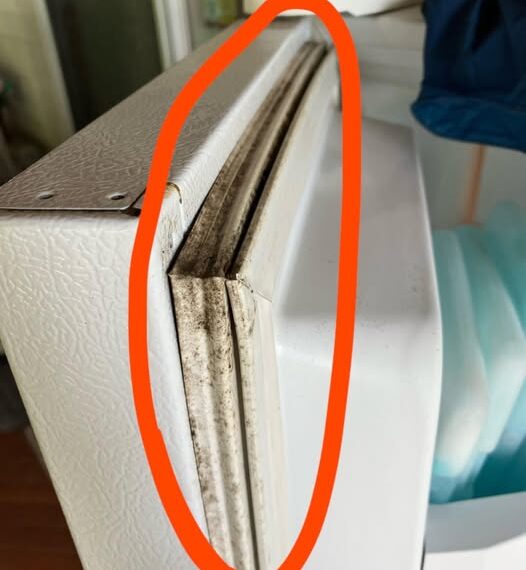Short answer: yes, it can be.
Not every type of black mold is toxic, but some strains, such as Stachybotrys chartarum, can release mycotoxins that cause respiratory issues, allergic reactions, or worsen asthma—especially in children and people with compromised immune systems. And even if it’s not the super-toxic kind, it’s still not something you want hanging around your food.
Every time you open the fridge, you risk releasing mold spores into the air, and worse, those spores could potentially land on your food. No thanks.
What You’ll Need to Clean Mold Off Your Fridge Gasket
The good news? Cleaning mold from your refrigerator gasket is surprisingly quick and easy. You probably already have the supplies in your kitchen or laundry cabinet.
Here’s what you’ll need:
- White vinegar (natural disinfectant and mold killer)
- Baking soda (gentle abrasive and deodorizer)
- Old toothbrush or soft scrub brush
- Spray bottle
- Clean microfiber cloths or paper towels
- Cotton swabs (optional, for tight corners)
- Dish soap (optional, for grease and food residue)
Optional but useful:
- Hydrogen peroxide (an effective mold killer)
- Gloves (to protect your hands)
Step-by-Step: How to Clean Mold From Your Refrigerator Gasket
Step 1: Inspect and Prepare
Open your fridge door and take a good look at the gasket. Gently pull it back with your fingers—you may be shocked at how much grime is hiding in the folds.
If the mold has been there for a while, the smell might be musty or sour. Don’t worry, we’re going to fix that.
Step 2: Make Your Cleaning Solution
You can choose from a couple of natural cleaning options:
Option 1: Vinegar Spray
- Mix equal parts white vinegar and water in a spray bottle.
Option 2: Vinegar + Baking Soda Paste
- Sprinkle baking soda directly on the mold, then spray with vinegar.
- It will fizz—this reaction helps lift the mold and grime.
Option 3: Hydrogen Peroxide (for tougher mold)
- Use 3% hydrogen peroxide directly on the gasket. Let it sit for a few minutes before scrubbing.
Note: Do not mix vinegar and hydrogen peroxide together in the same container—it’s not safe.
Step 3: Apply the Cleaner
Spray or apply your cleaning solution generously along the gasket, paying special attention to creases and corners where mold hides.
Let it sit for 5–10 minutes to give it time to break down the mold and loosen dirt.
Step 4: Scrub Away the Mold
Use an old toothbrush or a soft-bristled scrub brush to gently but thoroughly clean the gasket. Work in small sections, scrubbing in circular motions.
For tight spots, dip a cotton swab in the solution and run it through the crevices.
Step 5: Wipe Clean
Using a damp microfiber cloth or clean paper towels, wipe down the gasket to remove the mold and cleaning solution.
Rinse the cloth with warm water and repeat if needed. You want to remove all the residue.
Step 6: Dry Completely
Use a clean dry towel to thoroughly dry the gasket. Moisture is mold’s best friend, so leaving the area damp could restart the cycle.
Preventing Mold from Coming Back
Now that your gasket is clean and fresh, here’s how to keep it that way:
✅ Clean the Gasket Monthly
A simple wipe-down with vinegar or soapy water once a month will prevent mold from coming back.
✅ Keep the Gasket Dry
If you notice condensation or spills, wipe them up immediately. A dry gasket is a mold-free gasket.
✅ Avoid Overpacking Your Fridge
When the fridge is too full, the door may not seal properly, which causes cold air leaks and excess condensation.
✅ Use Baking Soda in the Fridge
Place an open box of baking soda inside to absorb odors and moisture.
✅ Inspect for Damage
If the gasket is cracked, torn, or not sealing properly, consider replacing it. Damaged gaskets are harder to clean and more prone to mold.
Natural vs. Chemical Cleaners: Which Should You Use?
If you’re concerned about harsh chemicals near your food, natural cleaners like vinegar, baking soda, and hydrogen peroxide are safe and effective for most household molds. However, if the mold is deeply embedded or recurring often, a commercial mold cleaner may be necessary.
Just be sure to follow directions and rinse thoroughly afterward to keep the fridge food-safe.
Final Thoughts: A Clean Fridge = Peace of Mind
Black mold on your refrigerator gasket isn’t just unpleasant—it’s unsanitary and potentially harmful. But don’t panic. With a few household items and less than 15 minutes of effort, you can completely banish it and restore freshness to your fridge.
This is one of those small home hygiene tasks that has a big impact. Plus, there’s something satisfying about knowing the place that stores your food is truly clean—from the inside out.
So next time you’re deep cleaning your kitchen, don’t forget the fridge gasket. Your nose, your health, and your leftovers will thank you. 💚





